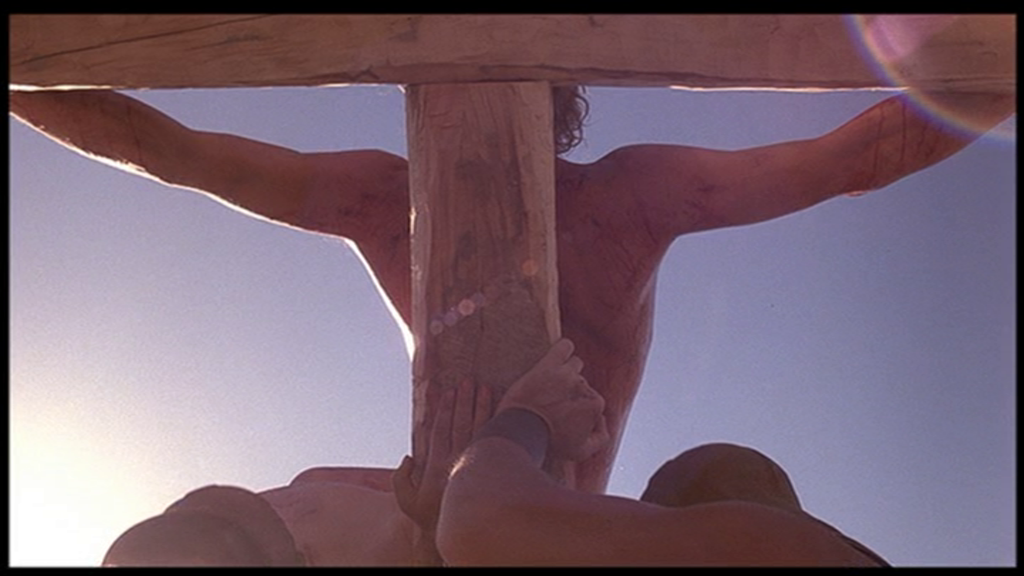

“I used that in THE EXORCIST. There’s a shot of, uh, well, frankly it’s a shot of a character being grabbed by the scrotum.”
William Friedkin, speaking in PSYCHO extra feature In the Master’s Shadow: Hitchcock’s Legacy, comparing Martin Balsam’s death scene in PSYCHO to a shot in his own shocker. His use of the word “frankly” I find, frankly, hilarious.
But he’s wrong.
This is a passable doc — what’s frustrating is they have people of the calibre of Scorsese, Carpenter, Friedkin, but they have to make room for Eli Roth and the composer of BASIC INSTINCT 2. There’s an assortment of editors and sound designers, and they mainly earn their presence by saying interesting or amusing things.

There’s also a colorized shot from Alfred Hitchcock Presents where they give Hitch a hideously crimson, ready-to-burst head, which looks set momentarily to take flight from his collar and go off to star in an Albert Lamorisse short. Or like somebody’s grabbed him by frankly the scrotum. My photo off the TV screen does not capture the full horror.
Friedkin tells us that he “found out” how Hitchcock filmed Balsam’s topple down the Bates house stairs, and duplicated it by attaching the camera to his scrotum agony man. Which isn’t what Hitch did at all, so I wonder what the “finding out” consisted of.
Hitchcock achieved his shot with rear projection, which most viewers can tell, I think. It looks as if Balsam is attached to the camera because he doesn’t move in relation to it. He’s sitting on a gimbal so he can sway from side to side but nobody seems to have thought of sitting that on a dolly so his distance from the camera can vary. The unreality of the effect is dreamlike, and Friedkin seems to have latched onto this bug and treated it as a feature.

The moving background was shot with what Hitch called “the monorail,” a kind of STAIRLIFT OF TERROR attached to the banister which let the operator slide smoothly down from landing to hallway.
The shot in THE EXORCIST always struck me as a bit of a blunder. It’s the kind of tricksy effect Friedkin normally eschewed in the name of realism. Screenwriter William Peter Blatty stuffed his first draft with fancy effects, and Friedkin tore them all out. A particularly extreme or striking shot should accompany important dramatic moments, I feel. Well, THE EXORCIST is full of traumatic stuff, but it seems to me that a mere ball-crushing, inflicted upon an insignificant character whose testicles play no further role in the story, doesn’t rate this kind of splashy treatment.
The shot goes by really fast, though, so I don’t think it does much harm. I mean, I would say that, they’re not my balls.
Supposing Hitchcock HAD attached a camera to Balsam, though. He’d still have had to devise a way to get his actor to stumble backward downstairs without breaking his neck (or the camera), so he’d still have needed a monorail. But a bigger one. And the resulting movement of the actor would be just as unreal, although I guess he’s have been more IN THE SCENE, instead of the sort of Cocteauesque feeling we get. Which would have been even more of a mismatch for THE EXORCIST, so in a way Friedkin misinterpreting or being misinformed about the PSYCHO shot worked to his benefit.


In the same piece, Scorsese talks about being influenced by the shower scene for the bit in RAGING BULL where Sugar Ray delivers an apocalyptic pounding to Jake LaMotta’s face-bones. And nifty intercutting of the two sequences creates a real sense of connectedness, with many shots appearing like exact analogs of one another. PSYCHO, of course, has no counterpart to the brief shots where DP Michael Chapman attached his camera to Sugar Ray’s arm, so that his boxing glove sits in the foreground, a leathery planetoid, a spherical scrotum agony man locked in position, while Robert DeNiro’s spurting face seems to lunge forward for a violent collision. This kind of FREAK SHOT is, again, a little much, but Scorsese and Thelma Schoonmaker cut the shots so tight you can’t quite register how odd it is, and it pretty much scuds by as just part of a generalized onslaught. Scorsese had a similar angle in LAST TEMPTATION OF CHRIST, the camera mounted on the arm of the cross as Christ hauls it along, but he didn’t use it. Too wacky. The only comparable angle is the view from the top of the cross as it’s raised into position — which he nicked (honourably) from Nick Ray’s KING OF KINGS.
Of course, LaMotta on the ropes is another Christ-figure, in the classic aeroplane pose.
(In framegrabbing that shot, I realize it’s a very different angle, though with the same crosscam effect, and there’s another shot moments earlier where the camera is attached to a hammer nailing Willem Dafoe or a disposable body double to the crossbeam. Also, arguably, too wacky, but again it’s quick and also we can at least agree that the moment is an important one, worthy of special effort.)



